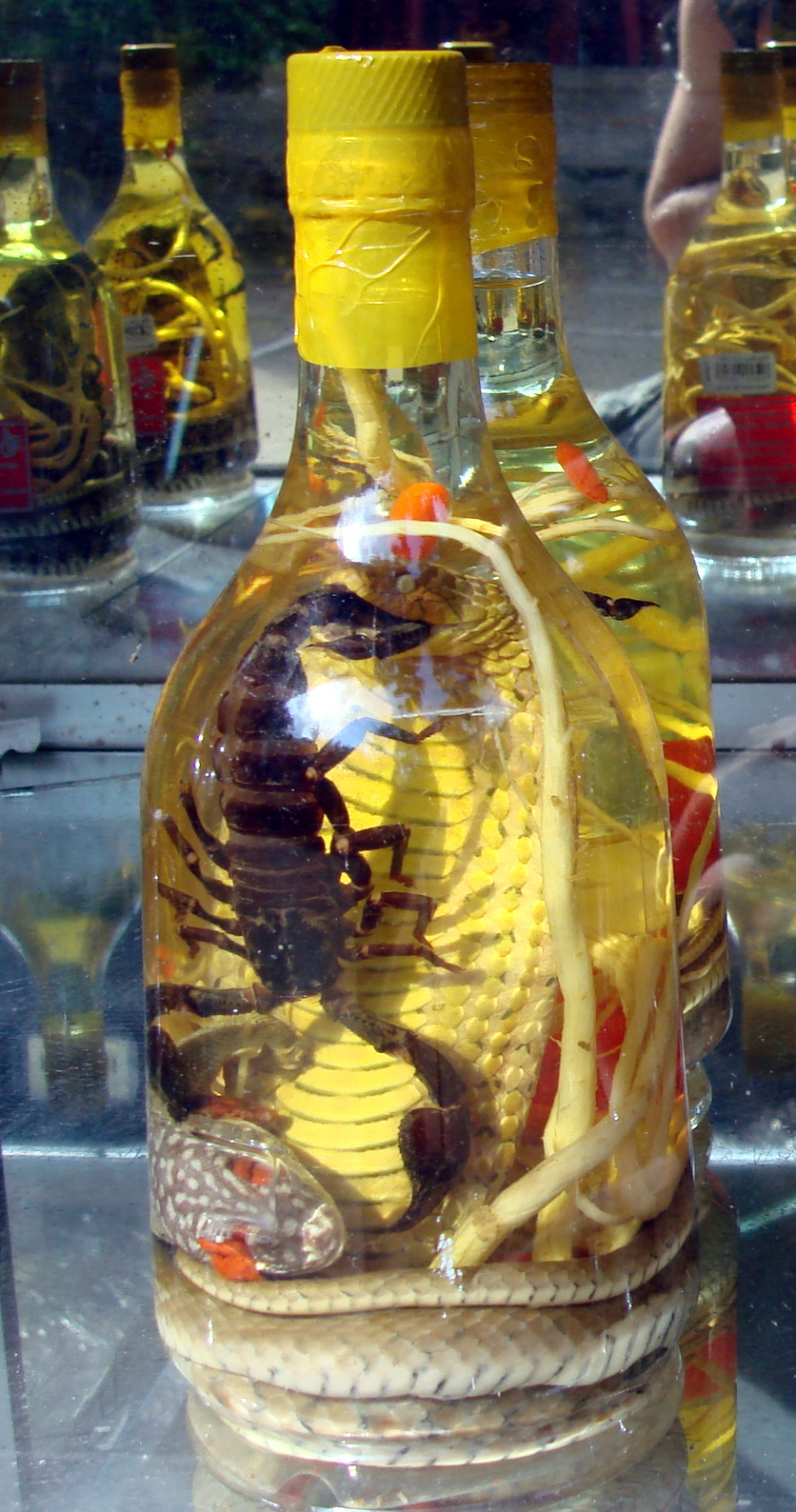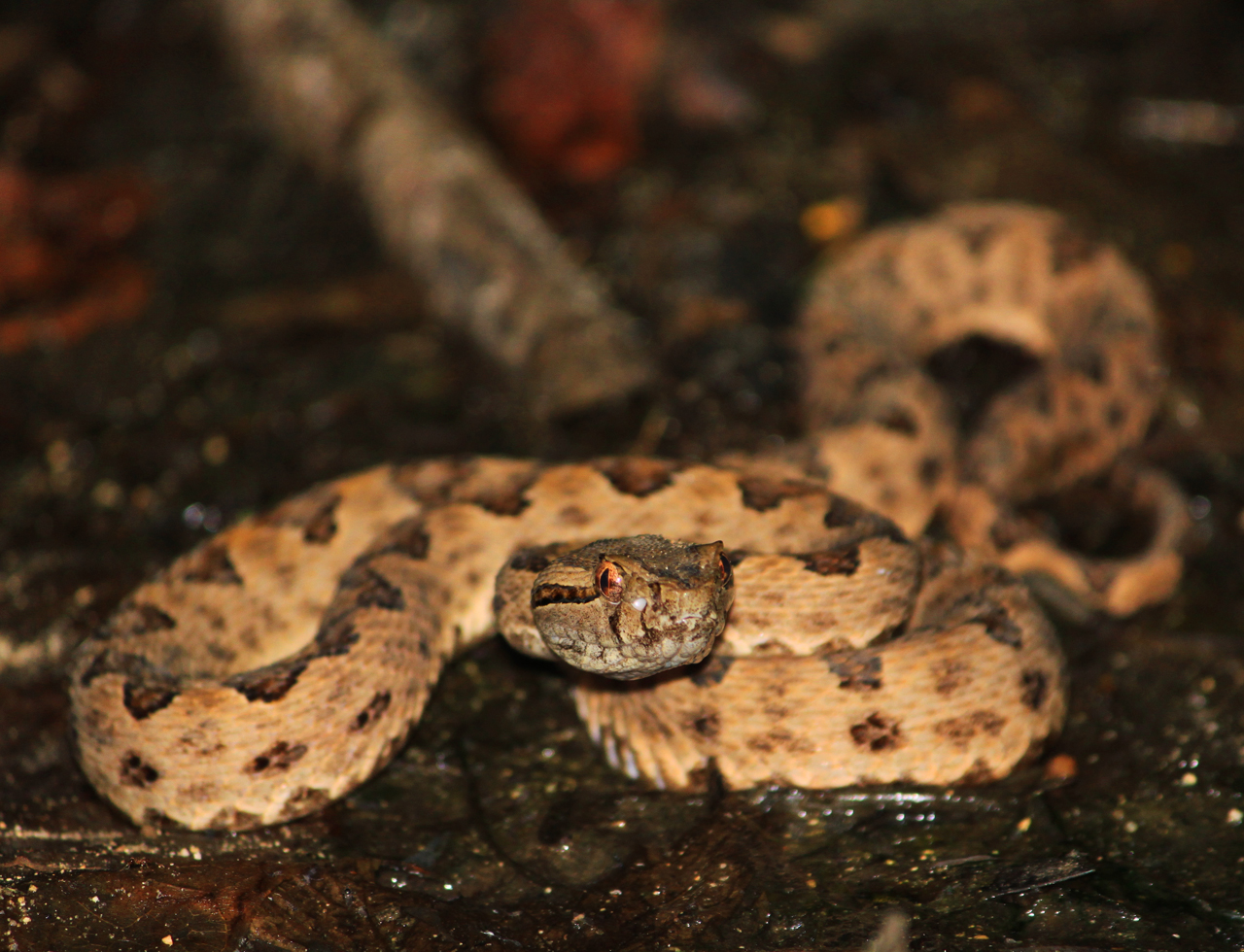|
Habushu
is an ''awamori''-based liqueur made in Okinawa, Japan. Other common names include Habu Sake or Okinawan Snake Wine. Habushu is named after the habu snake, ''Trimeresurus flavoviridis'', which belongs to the pit viper family and is closely related to the rattlesnake and copperhead. Habu snakes are venomous and native to areas in Southeast Asia and other large island groups including the Philippines, Ryukyus, and Japan. A bite from a habu snake can cause nausea, vomiting, hypotension, and possibly death. There have been cases where victims report the loss of motor function in hands and legs following treatment. Production A main distributor of habushu uses around 5,000 habu per year. The distillery uses crushed rice and Koji mold to produce the awamori that goes into the habushu. The ''awamori'' is first mixed with herbs and honey giving the clear liquid a yellow hue. A pit viper is then inserted into the liquid and stored until consumed. It is a typical practice to age the ... [...More Info...] [...Related Items...] OR: [Wikipedia] [Google] [Baidu] |
Awamori
''Awamori'' (, Okinawan: , āmui'') is an alcoholic beverage indigenous and unique to Okinawa, Japan. It is made from long grain indica rice, and is not a direct product of brewing (like ''sake'') but of distillation (like ''shōchū''). The majority of ''awamori'' made today uses indica rice imported from Thailand, as the local production is largely insufficient to meet domestic demand. ''Awamori'' is typically 60–86 proof (30–43% alcohol), although "export" brands (including brands shipped to mainland Japan) are increasingly 50 proof (25% alcohol). Some styles (notably '' hanazake'') are 120 proof (60%) and are flammable. ''Awamori'' is aged in traditional clay pots to improve its flavor and mellowness. The most popular way to drink ''awamori'' is with water and ice. When served in a restaurant in Okinawa, it will nearly always be accompanied by a container of ice and carafe of water. ''Awamori'' can also be drunk straight, on the rocks, and in cocktails. Tradition ... [...More Info...] [...Related Items...] OR: [Wikipedia] [Google] [Baidu] |
Trimeresurus Flavoviridis
''Protobothrops flavoviridis'' is a species of venomous pit viper endemic to the Ryukyu Islands of Japan. No subspecies are currently recognized. Local common names include habu,Gumprecht A, Tillack F, , Captain A, Ryabov S. 2004. ''Asian Pitvipers''. GeitjeBooks. Berlin. 1st Edition. 368 pp. . Okinawa habu,U.S. Navy. 1991. ''Poisonous Snakes of the World''. US Govt. New York: Dover Publications Inc. 203 pp. . and Kume Shima habu.Mehrtens JM. 1987. ''Living Snakes of the World in Color''. New York: Sterling Publishers. 480 pp. .'' Description Growing to an average total length of , with a maximum of , this is the largest member of its genus. It is slenderly built and gracefully proportioned with a large head. The crown of the head is covered with small scales. ''P. flavorviridis'' has a light olive or brown ground color, overlaid with elongated dark green or brownish blotches. The blotches have yellow edges, sometimes contain yellow spots, and frequently fuse to produce wavy ... [...More Info...] [...Related Items...] OR: [Wikipedia] [Google] [Baidu] |
Sake
Sake, also spelled saké ( ; also referred to as Japanese rice wine), is an alcoholic beverage of Japanese origin made by fermenting rice that has been polished to remove the bran. Despite the name ''Japanese rice wine'', sake, and indeed any East Asian rice wine (such as huangjiu and cheongju), is produced by a brewing process more akin to that of beer, where starch is converted into sugars which ferment into alcohol, whereas in wine, alcohol is produced by fermenting sugar that is naturally present in fruit, typically grapes. The brewing process for sake differs from the process for beer, where the conversion from starch to sugar and then from sugar to alcohol occurs in two distinct steps. Like other rice wines, when sake is brewed, these conversions occur simultaneously. The alcohol content differs between sake, wine, and beer; while most beer contains 3–9% ABV, wine generally contains 9–16% ABV, and undiluted sake contains 18–20% ABV (although this is o ... [...More Info...] [...Related Items...] OR: [Wikipedia] [Google] [Baidu] |
Snake Wine
Snake wine (; vi, rượu rắn; km, ស្រាពស់, ) is an alcoholic beverage produced by infusing whole snakes in rice wine or grain alcohol. The drink was first recorded to have been consumed in China during the Western Zhou dynasty (c. 1040–770 BC) and considered an important curative and believed to reinvigorate a person according to Traditional Chinese medicine. It can be found in China, North-Korea, Goa (India), Vietnam, Okinawa (Japan), Laos, Thailand, Cambodia and throughout Southeast Asia. The snakes, preferably venomous ones, are not usually preserved for their meat but to have their "essence" and/or snake venom dissolved in the liquor. The snake venom proteins are unfolded by the ethanol and therefore the completed beverage is usually, but not always, safe to drink. The Huaxi street night market () of Taipei, Taiwan, is renowned for its snake foods and wine products. History Snakes and their viscera have long been considered by followers of Tra ... [...More Info...] [...Related Items...] OR: [Wikipedia] [Google] [Baidu] |
:Category:Japanese Words And Phrases ...
{{Commons Words and phrases by language Words Words Words A word is a basic element of language that carries an objective or practical meaning, can be used on its own, and is uninterruptible. Despite the fact that language speakers often have an intuitive grasp of what a word is, there is no conse ... [...More Info...] [...Related Items...] OR: [Wikipedia] [Google] [Baidu] |
Habu Liqueur, Awamori Flavoured With Snakes And Herbs
is a Ryukyuan and Japanese name referring to certain venomous snakes: * The following species are found in the Ryukyu Islands of Japan: ** ''Protobothrops elegans'', a.k.a. the Sakishima habu, found in the southern Ryukyu Islands ** '' Protobothrops flavoviridis'', a.k.a. the Okinawan habu, found in the southern Ryukyu Islands ** ''Protobothrops tokarensis'', a.k.a. the Tokara habu, found in the Tokara Islands ** ''Ovophis okinavensis'', a.k.a. the Hime habu * Habu is a name also used for several other species: ** ''Trimeresurus gracilis'', a.k.a. the Kikushi habu, found in Taiwan. ** ''Protobothrops mucrosquamatus'', a.k.a. the Taiwan habu or Chinese habu, found in Southeast Asia. ** ''Ovophis monticola'', a.k.a. the Arisan habu, found in Southeast Asia. * ''Habu'' is a nickname given to the Lockheed SR-71 Blackbird The Lockheed SR-71 "Blackbird" is a long-range, high-altitude, Mach 3+ strategic reconnaissance aircraft developed and manufactured by the American aer ... [...More Info...] [...Related Items...] OR: [Wikipedia] [Google] [Baidu] |
Liqueur
A liqueur (; ; ) is an alcoholic drink composed of spirits (often rectified spirit) and additional flavorings such as sugar, fruits, herbs, and spices. Often served with or after dessert, they are typically heavily sweetened and un-aged beyond a resting period during production, when necessary, for their flavors to mingle. Liqueurs are historical descendants of herbal medicines. They were made in Italy as early as the 13th century, often prepared by monks (for example, Chartreuse). Today they are produced all over the world, commonly served neat, over ice, with coffee, in cocktails, and used in cooking. Etymology The French word ''liqueur'' is derived from the Latin ''liquifacere'', which means "to dissolve". In some parts of the United States and Canada, liqueurs may be referred to as cordials, or schnapps. This can cause confusion as in the United Kingdom a cordial would refer to a non-alcoholic concentrated fruit syrup, typically diluted to taste and consumed as ... [...More Info...] [...Related Items...] OR: [Wikipedia] [Google] [Baidu] |
Okinawa Prefecture
is a prefecture of Japan. Okinawa Prefecture is the southernmost and westernmost prefecture of Japan, has a population of 1,457,162 (as of 2 February 2020) and a geographic area of 2,281 km2 (880 sq mi). Naha is the capital and largest city of Okinawa Prefecture, with other major cities including Okinawa, Uruma, and Urasoe. Okinawa Prefecture encompasses two thirds of the Ryukyu Islands, including the Okinawa, Daitō and Sakishima groups, extending southwest from the Satsunan Islands of Kagoshima Prefecture to Taiwan ( Hualien and Yilan Counties). Okinawa Prefecture's largest island, Okinawa Island, is the home to a majority of Okinawa's population. Okinawa Prefecture's indigenous ethnic group are the Ryukyuan people, who also live in the Amami Islands of Kagoshima Prefecture. Okinawa Prefecture was ruled by the Ryukyu Kingdom from 1429 and unofficially annexed by Japan after the Invasion of Ryukyu in 1609. Okinawa Prefecture was officially founded in 1879 by ... [...More Info...] [...Related Items...] OR: [Wikipedia] [Google] [Baidu] |
Japan
Japan ( ja, 日本, or , and formally , ''Nihonkoku'') is an island country in East Asia. It is situated in the northwest Pacific Ocean, and is bordered on the west by the Sea of Japan, while extending from the Sea of Okhotsk in the north toward the East China Sea, Philippine Sea, and Taiwan in the south. Japan is a part of the Ring of Fire, and spans an archipelago of 6852 islands covering ; the five main islands are Hokkaido, Honshu (the "mainland"), Shikoku, Kyushu, and Okinawa. Tokyo is the nation's capital and largest city, followed by Yokohama, Osaka, Nagoya, Sapporo, Fukuoka, Kobe, and Kyoto. Japan is the eleventh most populous country in the world, as well as one of the most densely populated and urbanized. About three-fourths of the country's terrain is mountainous, concentrating its population of 123.2 million on narrow coastal plains. Japan is divided into 47 administrative prefectures and eight traditional regions. The Greater Tokyo Ar ... [...More Info...] [...Related Items...] OR: [Wikipedia] [Google] [Baidu] |
Pit Viper
The Crotalinae, commonly known as pit vipers,Mehrtens JM (1987). ''Living Snakes of the World in Color''. New York: Sterling Publishers. 480 pp. . crotaline snakes (from grc, κρόταλον ''krotalon'' castanet), or pit adders, are a subfamily of vipers found in Eurasia and the Americas. Like all other vipers, they are venomous. They are distinguished by the presence of a heat-sensing pit organ located between the eye and the nostril on both sides of the head. Currently, 23 genera and 155 species are recognized: These are also the only viperids found in the Americas. The groups of snakes represented here include rattlesnakes, lanceheads, and Asian pit vipers. The type genus for this subfamily is '' Crotalus'', of which the type species is the timber rattlesnake, ''C. horridus''. These snakes range in size from the diminutive hump-nosed viper, '' Hypnale hypnale'', that grows to a typical total length (including tail) of only , to the bushmaster, '' Lachesis muta'' ... [...More Info...] [...Related Items...] OR: [Wikipedia] [Google] [Baidu] |
Rattlesnake
Rattlesnakes are venomous snakes that form the genera '' Crotalus'' and '' Sistrurus'' of the subfamily Crotalinae (the pit vipers). All rattlesnakes are vipers. Rattlesnakes are predators that live in a wide array of habitats, hunting small animals such as birds and rodents. Rattlesnakes receive their name from the rattle located at the end of their tails, which makes a loud rattling noise when vibrated that deters predators or serves as a warning to passers-by. Rattlesnakes are the leading contributor to snakebite injuries in North America, but rarely bite unless provoked or threatened; if treated promptly, the bites are seldom fatal. The 36 known species of rattlesnakes have between 65 and 70 subspecies, all native to the Americas, ranging from British Columbia through Ontario in southern Canada, to central Argentina. The largest rattlesnake, the eastern diamondback, can measure up to in length. Rattlesnakes are preyed upon by hawks, weasels, king snakes, and ... [...More Info...] [...Related Items...] OR: [Wikipedia] [Google] [Baidu] |







.jpg)